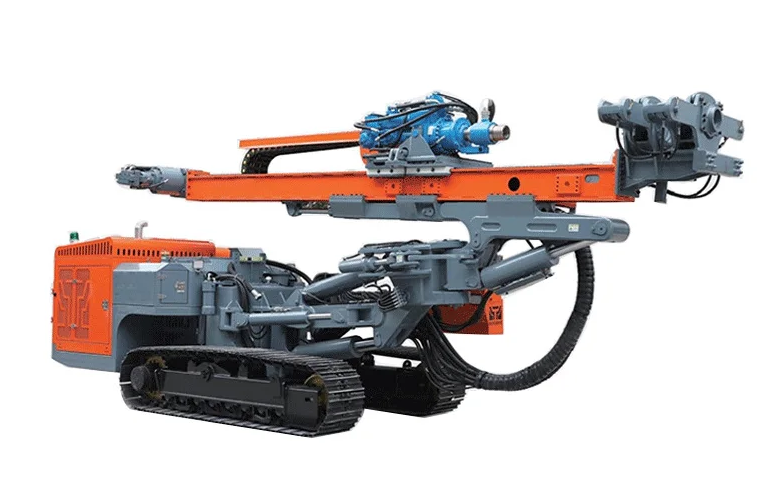 English
English שפה עברית
שפה עברית  Kurdî
Kurdî  Español
Español  Português
Português  русский
русский  tiếng Việt
tiếng Việt  ภาษาไทย
ภาษาไทย  Malay
Malay  Türkçe
Türkçe  العربية
العربية  فارسی
فارسی  Burmese
Burmese  Français
Français  日本語
日本語  Deutsch
Deutsch  Italiano
Italiano  Nederlands
Nederlands  Polski
Polski  한국어
한국어  Svenska
Svenska  magyar
magyar  বাংলা ভাষার
বাংলা ভাষার  Dansk
Dansk  Suomi
Suomi  हिन्दी
हिन्दी  Pilipino
Pilipino  Gaeilge
Gaeilge  Indonesia
Indonesia  Norsk
Norsk  تمل
تمل  český
český  ελληνικά
ελληνικά  український
український  Javanese
Javanese  தமிழ்
தமிழ்  తెలుగు
తెలుగు  नेपाली
नेपाली  български
български  ລາວ
ລາວ  Latine
Latine  Қазақша
Қазақша  Euskal
Euskal  Azərbaycan
Azərbaycan  Slovenský jazyk
Slovenský jazyk  Македонски
Македонски  Lietuvos
Lietuvos  Eesti Keel
Eesti Keel  Română
Română  Slovenski
Slovenski
How Does a DTH (Down-The-Hole) Mining Drilling Rig Work?
2025-10-31
How Does a DTH (Down-The-Hole) Mining Drilling Rig Work?
The Down-The-Hole (DTH) hammer is a powerful and efficient drilling technology widely used in mining, quarrying, and water well drilling. A mining drilling rig equipped with a DTH system is particularly effective in penetrating hard, abrasive rock formations where other methods may be slow or experience excessive bit wear. The fundamental principle that sets DTH apart is the placement of the percussion mechanism—the hammer—directly behind the drill bit at the bottom of the borehole, rather than at the top of the drill string. This configuration allows for direct energy transfer to the rock, resulting in higher penetration rates and straighter holes.
The core components of a DTH system on a mining drilling rig are the top sub or shank adapter, the outer hammer casing, the piston (hammer), the check valve, and the drill bit. The entire assembly is attached to the bottom of the drill string. The process is powered by high-pressure compressed air, which is supplied by a large air compressor on the surface, integral to the mining drilling rig package. This air travels down the annulus between the drill rods and the hammer casing. A portion of this air is also directed through the center of the drill string to help clear cuttings, but the primary flow for hammer operation is through the annulus.

The drilling cycle begins when the high-pressure air enters the hammer assembly through ports in the top sub. The air pressure drives the piston upwards, compressing a spring or creating an air cushion. Once the piston reaches the top of its stroke, it uncovers an air channel that redirects the high-pressure air to the top of the piston. This rapid pressure reversal forcefully drives the piston down onto the back of the drill bit. The impact energy is transmitted directly from the piston to the bit, which then crushes the rock beneath it. This cycle of lifting and striking repeats many times per second, typically between 10 and 30 Hz, depending on the hammer design and air pressure.
Simultaneously, the system efficiently removes the rock cuttings. After the air has performed its work in actuating the piston, it is exhausted down through the center of the bit, exiting through holes or ports directly onto the rock face. This high-velocity air stream flushes the crushed cuttings from the bottom of the hole and carries them up the annular space between the drill string and the borehole wall to the surface. The use of the entire drill string annulus as a return path for cuttings allows for efficient clearing, which is vital for maintaining drilling speed and preventing the bit from becoming stuck. The bit itself is typically equipped with tungsten carbide buttons that are designed to withstand the immense impact forces and abrasion.
The advantages of using a DTH mining drilling rig are significant. Because the hammer impacts the rock directly at the bottom of the hole, there is minimal energy loss up the drill string, making it very efficient, especially in deep holes. The constant hammering action on the bit also helps to keep the drill string rotating in a steady manner, which contributes to drilling a straighter hole compared to some other methods. DTH rigs are the preferred choice for large-diameter blastholes in hard rock open-pit mines, for dewatering wells, and for any application that requires rapid and reliable penetration of challenging formations. The robustness of the system, when paired with a powerful mining drilling rig and compressor, makes it a cornerstone of modern mineral extraction and construction.




